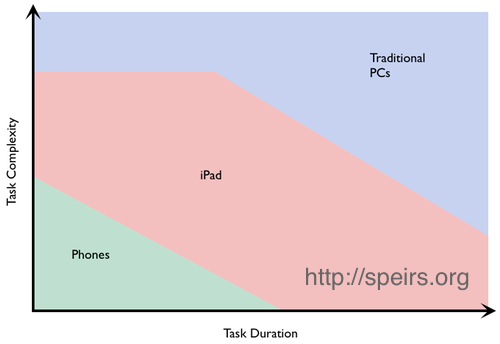Ongoing Onboarding: How Duolingo Introduces New Skills
Continue to Ongoing Onboarding: How Duolingo Introduces New Skills…
When we began exploring smartphone and tablet usability research just five years ago, most of our clients showed little interest. The vast majority of website visitors were desktop PC users at that time. But we had a hunch that was about to change.
Over the next couple years, smartphone usage began its meteoric rise and client interest in mobile user research spiked. Today, smartphones are ubiquitous and most of our user research is conducted on multiple devices.
One thing that’s remained constant over this time is our clients’ question: Will our customers use a smartphone for complex tasks on their website or web applications? To help answer this question, we can look at market trends and industry research – and some anecdotal observations from our mobile usability lab.
There is little doubt that manufacturers are beginning to merge the functionality of the smartphone and the PC. Apple has made the Mac a companion to a nearby iPhone while Google is making the Chromebook interoperable with a nearby Android phone. In the near future, your smartphone may use Bluetooth to pair with a keyboard and monitor wherever you are – thereby eliminating the need for a PC.
In the meantime, a sea change is already happening in the evolution of the smartphone. Popularity of very large smartphones – often called “phablets” – has exploded, chipping away at the market share of medium-sized smartphones and full-size tablets. Among Android phones, 27% are now phablets and the iPhone 6 Plus gained 10% of Apple’s market share in just its first year.
Two themes are apparent when reviewing the existing research on this topic.
It can be tempting for office workers to assume nobody would want to access complex functionality on their phone. But there’s a crucial difference between “want to” and “have to.”
You may not be aware of the significant portion of the population for whom smartphones provide their only access to online tools and content.
According to Pew Research Center, 15% of smartphone users have limited alternate options for accessing the web. Certain demographic groups are over-represented as smartphone-dependent: younger adults, those with low household incomes and levels of education and non-whites.
PCs remain superior for completing tasks that are complex, that take a long time, and for multi-tasking.
When given the choice, users will avoid doing complex tasks on their phone. Understanding large amounts of information and typing on a smaller screen can be difficult. Tablets, thanks to the larger screen, are able to accommodate a much wider variety of tasks.

While the most complex tasks will remain the realm of traditional PCs for some time, an overall shift away from PCs will continue with advancements in smartphones and tablets like increased processing power, better battery life, larger screens and faster network speeds.
As Josh Valcarcel put it in a recent story for WIRED, “We’re living proof: for the last two years, WIRED has been able to cover events like CES almost exclusively using our smartphones.”
At Crux Collaborative, we often lament the poor web browsing experiences that dominated in the early years of smartphones. Were those experiences so bad that they permanently branded the user’s consciousness?
In study after study, we see users go straight for a “Full Site” link so they can use the “real” site. They would prefer to use a PC. However, when shown a well-designed mobile experience, they express delight at how unexpectedly easy and enjoyable it can be to complete that task on a phone. In other cases, we see users comfortable using their phone even for very complex tasks.
But ultimately, the most common type of user we encounter does not use one device or the other. She uses a PC at work, a smartphone while waiting in line at the grocery store, and a tablet while watching TV at night. Or some other such combination.
It helps if we think of tasks in a continuum from very complex, to moderately complex, to simple. We can conclude that ALL tasks must be available to smartphone users — even very complex tasks. Hiding tasks is not an ethical option.
Research shows, however, most users will avoid these very complex tasks on their phones if they can. And we must acknowledge that project budgets require prioritization. With phone screen sizes trending larger, it makes little sense to invest heavily in new solutions for the most complex tasks on smaller-sized screens. Instead, we should make their larger-screen solution available to smartphone users — with full functionality.
What does make sense is to recognize that phone screens are getting bigger and users will become more and more comfortable with moderately complex tasks. These tasks should be designed with a mobile-first mindset because, yes – many of your users will use their phone for those kind of tasks.
Are you redesigning with mobile users in mind? Contact us to understand your options. Whether you are looking for some quick fixes or a complete overhaul of your mobile presence we can help you understand and define your mobile experience.
Continue to Ongoing Onboarding: How Duolingo Introduces New Skills…